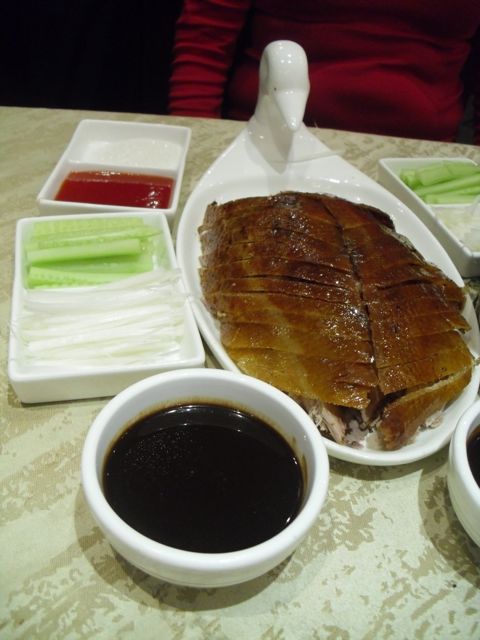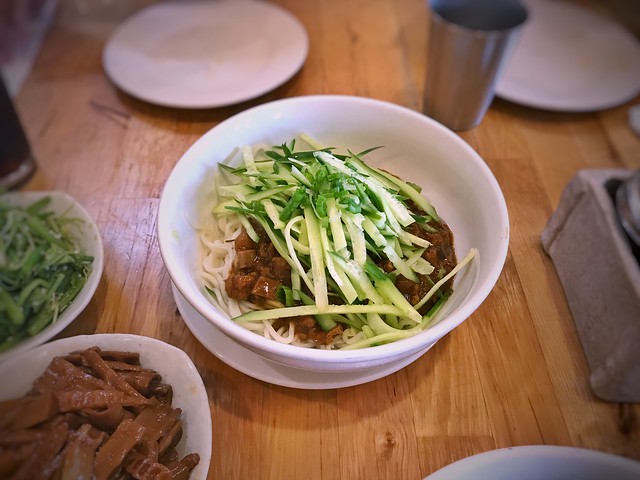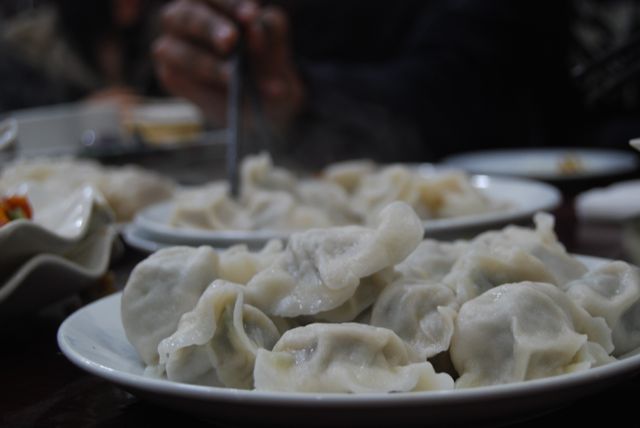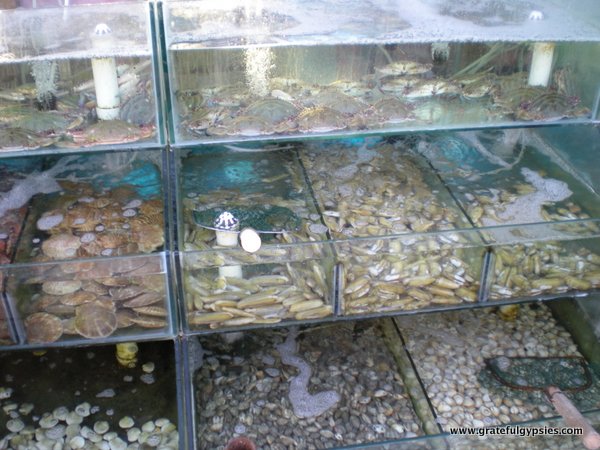Northern Chinese Food Posted by sasha on Apr 22, 2019 in Culture
One of the most common questions I get asked about living in China is “What’s real Chinese food like?” Well, it’s really hard to generalize Chinese food. One thing’s for sure, though – real Chinese food is a stark contrast from the sweet & sour chicken, egg rolls, and fortune cookies that are served up in most American Chinese restaurants. We’ve already taken a closer look at Cantonese food as well as Western Chinese cuisine (Sichuan and Hunan), so today we’re heading in a different direction as we learn about Northern Chinese food (北方菜 – běi fāng cài).
An Intro to Northern Chinese Cuisine
Northern cuisine includes food from Beijing, as well as the provinces of Shandong, Shanxi, Inner Mongolia, Northwest China, and the Northeast region, which is collectively known as Dongbei (东北 – dōng běi). The North experiences harsh, cold and dry winters, as well as incredibly hot summers, and the bold and salty flavors of the cuisine pair nicely with these rough weather conditions. It’s a long way from Xinjiang province to Heilongjiang, though, so let’s examine some of these different regions of the North individually.
Beijing
Of course, Beijing cuisine (北京菜 – běi jīng cài) is most famous for its Peking roast duck (北京烤鸭 – běi jīng kǎo yā). A longtime favorite of Chinese Emperors, this delicious duck is now considered one of the national dishes in China, and a restaurant specializing in it is a guaranteed stop on any tour of Beijing. For more on the royal bird, check out my post on the imperial bird.
Eating roast duck at the famous Da Dong (大董 – dà dǒng).
Beijing is also famous for its many snacks (小吃 – xiǎo chī), which are sold by street vendors or small shops throughout the city. Here are a few examples of some Beijing snacks:
Fried pancake (褡裢火烧 – dā lián huǒ shāo)
A pan-fried roll filled with delicious ingredients such as pork, lamb, cabbage, or green onion, they are fried golden brown but yet manage to remain soft. Dip these in some vinegar, soy sauce, or chili pepper for an extra kick.
Fried sauce noodles (炸酱面 – zhá jiàng miàn)
These are a staple in Beijing, and can be found just about anywhere. The “fried sauce” is salty fermented soybean paste, and it’s mixed in with some stir-fried ground pork, thick wheat noodles, and diced scallions and garlic.
US Vice President Joe Biden tried these out when he visited Beijing, and the restaurant where he ate now features the “Biden Set Lunch” – an exact replica of what the VP and his entourage ordered. His choice to eat in a local, inexpensive restaurant has been dubbed “Noodle Diplomacy.” Nothing like pigging out to solve geo-political issues!
Practice your listening in this video talking about Biden’s trip and other Beijing delicacies.
Beef tripe (爆肚 – bào dǔ)
Famous since the time of Emperor Qianlong, this tender and crispy snack can be found all over Beijing, in restaurants and on the street in several night markets. Sure, it is cow stomach, but if you’re in China, you might as well try it!
Mung bean milk (豆汁 – dòu zhī)
While this is a drink, it needs to be included in any list of Beijing snacks, as Beijingers love this funky looking and smelling bean milk. Don’t let the appearance or stench turn you off, though, as it’s high in protein and vitamin C and thus great for your health!
Northeast
Due to short growing seasons and very harsh winters, Northeastern cuisine (东北菜 – dōng běi cài) relies primarily on hearty dishes and preserved food. Unlike most other areas, where rice is predominant, wheat is more common in this region, with noodles, dumplings, and steamed buns all featuring heavily in the daily diet.
Here are a few common dishes:
Pickled cabbage (酸菜 – suān cài)
With a taste similar to sauerkraut, this pickled cabbage is often cooked in a stew with some pork – perfect for keeping you warm in those bitter cold winters.
Pork and scallion dumplings (猪肉大葱饺子 – zhū ròu dà cōng jiǎo zi)
The ubiquitous Chinese dumplings are all over the place in the Northeast, which should come as no surprise with temperatures well below freezing during the long, painful winter. Order up a plate of these bad boys, take a big swig of some 白酒, and you’ll be ready to brave the cold.
Lamb with cumin (孜然羊肉 – zī rán yáng ròu)
Stir-fried lamb with dried chillies and cumin seeds, this dish comes from the Mongols and is still very popular all throughout China, but especially in the Northeast.
Hot pot (火锅 – huǒ guō)
With how cold it gets up in Dongbei, it should come as no surprise that people love eating hot pot here. The concept is simple – you order up a pot of broth, wait for it to boil at your table, and add whatever you want to it.
When eating hot pot, you can choose a variety of meat, seafood, and vegetables. A popular choice is to split the broth so that one side is super spicy and the other is more mild. It’s the perfect meal to warm you up on a freezing winter day.
Lu (Shandong)
One of the most influential styles, Lu cuisine (鲁菜 – lǔ cài) was once a very important part of imperial cuisine. As Shandong province is on the coast, it should come as no surprise that seafood is prominent in many of the dishes.
In coastal cities like Qingdao, you can head out to a local restaurant and take your pick from an abundance of delicacies from the sea, including prawns, scallops, and squid.
Here are some classic Shandong dishes:
Braised abalone (原壳鲍鱼 – yuán ké bào yú)
Most seafood is cooked in some sort of light sauce, and both garlic and scallions are often used to add flavor. In this dish, the abalone are simmered in a sauced and served in their shells.
Sweet and sour carp (糖醋鲤鱼 – táng cù lǐ yú)
This is a famous traditional dish of Shandong province, and legend has it that it rose to fame in a small town by the Yellow River. This golden brown, crisp fish will certainly be fresh if you order it in Shandong, and the fragrant smell along with the sweet and sour tastes are sure to leave you satisfied.
Dezhou braised chicken (德州扒鸡 – dé zhōu bā jī)
It’s not all seafood that makes up Lu Cuisine. Take, for example, the fantastic braised chicken from the city of Dezhou. A chicken is deep-fried until it is slightly burned. Then, mushrooms, soy sauce, fruit, sugar, and spices are added. The result is a juice, tender, and savory chicken.
你饿了吗? (nǐ è le ma) – in Chinese, that’s “Are you hungry?” I’m sure you’re probably drooling over all of the amazing dishes covered in this post. Before you run off to eat some yummy Chinese food, though, try answering these questions:
你喜欢北方菜吗?
nǐ xǐ huān běi fāng cài ma
Do you like northern cuisine?
你吃过什么北方菜?
nǐ chī guò shèn me běi fāng cài
Which northern cuisine have you tried?

Build vocabulary, practice pronunciation, and more with Transparent Language Online. Available anytime, anywhere, on any device.









Leave a comment: